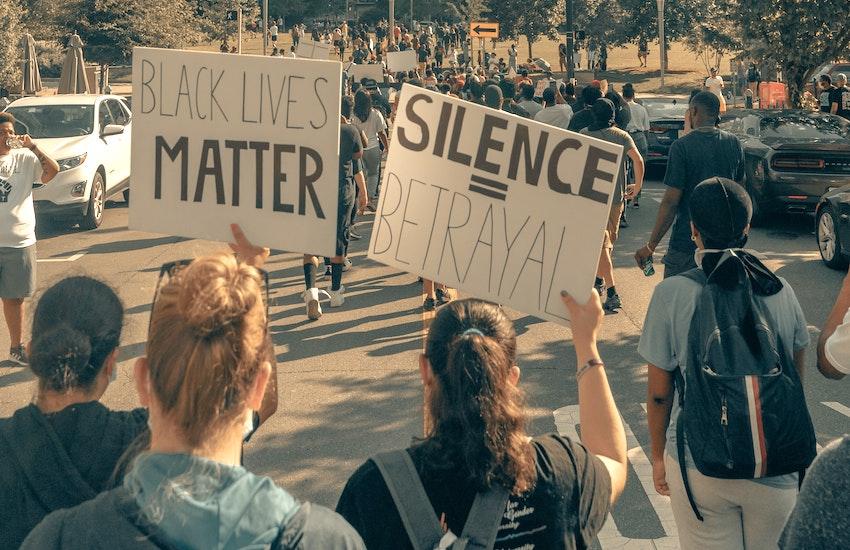How to Talk About George Floyd and Racism with Your Team
Published: Jun 03, 2020

If you're a manager, business owner, or C-suite executive and still finding it hard to know what to say or write in the wake of the death of George Floyd and ensuing protests, you'll want to take a look at the letter Boston Scientific sent to its employees last week.
What sets Boston Scientific's letter apart from most other corporate responses to the incident and anti-racists protests is it calls for its employees to take specific action, rather than merely denouncing Floyd's death. Even the title of the letter is a call to action of sorts: "An Open Letter from Boston Scientific Leadership on Standing Up to Intolerance and Racism."
Below is a breakdown of the letter, perhaps helping you to craft your own verbal or written response to George Floyd’s death and the protests that it has spawned.
Address the incident
The Boston Scientific letter's opening paragraphs address George Floyd's death head-on, getting straight to the point, describing the death in detail with no sugarcoating: "George Floyd, a black man, died in Minneapolis after being handcuffed and pinned to the ground by the knee of a white law enforcement official."
Then, the letter describes the implications of Floyd's death and what it's emblematic of: "George Floyd’s death reflects deeply ingrained, long-standing divisions in our society. And it comes at a time when the pandemic has given rise to hate and xenophobia around the world, with rampant acts of violence across the nation, and the spread of misinformation, racial stereotyping and fear."
Beginning like this sends a message right away that the writer (or writers) of the letter is taking this matter seriously and is not looking to mince words.
Tell your team why you're compelled to speak out
After acknowledging Floyd’s death and its implications, Boston Scientific's letter clearly lays out why it's being written: "As an executive committee, we feel compelled to condemn injustice and discrimination and to reaffirm our commitment to live by our values and cultivate a workplace that makes equality, diversity and openness priorities—a workplace that sets an example for the greater community."
A statement like this affirms the firm's values; expresses support for employees at a time when so many are hurting, grieving, upset, heartbroken, enraged; and commits, in writing, to creating (or continuing to create) a truly inclusive culture.
Give your team concrete actions to take
At the heart of Boston Scientific's letter, and what sets it apart from others, are three specific actions employees can take now to fight systemic racism:
- "Speak up when you experience or witness intolerance, mistreatment or bias in action. No matter what the issue, say something. If you don’t know what to say, start by asking, 'What did you mean by that?' Listen, then respond calmly based on facts. Saying nothing when such instances arise condones the discrimination or microaggression.
- Create an inclusive environment for everyone. Seek different perspectives, and respect points of view and communication styles that are different from your own.
- Process your feelings. Tragedies like this can feel traumatizing, especially for members of marginalized groups. Talking to friends and loved ones can help. Boston Scientific also makes mental health resources available for times when you may need more support through a dedicated employee well-being website and other places."
Giving a team actions like these to take is a bold move in a letter, but bold is what’s needed now. Bold is what employees want to hear. Bold is what employees want to be. Bold is what employees want in an employer, especially at this time.
Collectively sign off
Most company statements on the death of George Floyd have been signed by one individual: typically the company's CEO. But Boston Scientific's is signed by 16 individuals: its entire executive committee. What makes this so powerful and much more meaningful than a single signature is this: It signals to employees that the letter is not just the position of the faceless company or of one individual but many individuals, sending the message that its meaning reaches to every corner (or, at least, many corners) of the company.
Further, while a CEO might not be someone that most employees speak to regularly, if ever, there’s a good chance a management committee’s reach is wide, thus giving employees who need to speak with someone many names of those available for support.
For more help speaking with your team
Another resource to mine when trying to find the right words and actions to take at this time is an excellent Harvard Business Review article entitled “U.S. Businesses Must Take Meaningful Action Against Racism,” written by Laura Morgan Roberts, a professor at the University of Virginia Darden School of Business, and Ella F. Washington, a professor at Georgetown University’s McDonough School of Business. The article offers several helpful do’s and don’ts when it comes to discussing racism with your team.
Among the don’ts are: (1) “keeping silent,” “avoiding talking about race because [you] fear being seen as prejudiced”; (2) “becoming overly defensive,” “especially when [your] world views, positions, or advantages are questioned or challenged”; and (3) “overgeneralizing,” “making sweeping generalizations about groups of people involved in the public conflict.”
Among the do’s are: (1) “provide a framework for meaningful action,” “acknowledging any harm that your Black and brown coworkers have endured”; (2) “research to fully understand events, using data from reliable sources”; (3) “give your Black and brown employees the space to be angry, afraid, disenchanted, or even disengaged from work”; (4) “seek out support from your human resources team or office of diversity and inclusion,” (5) “affirm [your employees’] right to safety and personhood and help them feel protected”; and (6) “think critically about how you can use your power to effect change.”
